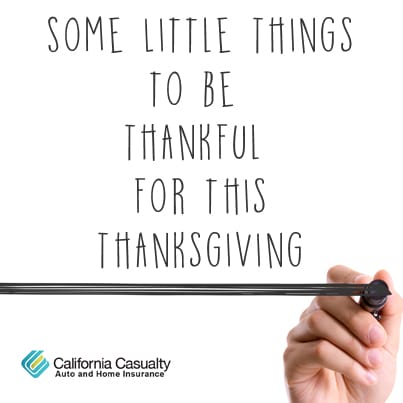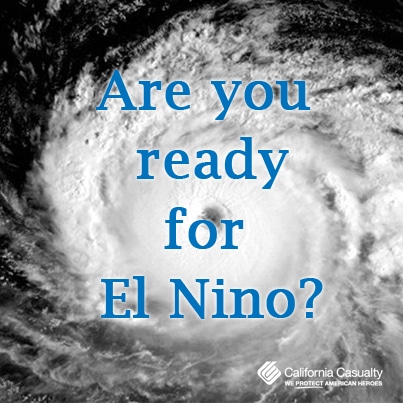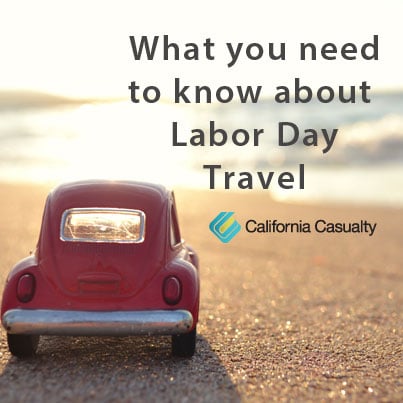by California Casualty | News |

Thanksgiving is the time we should pause and be thankful for so many things. While most of think of our jobs, families and our health, we might forget about other things in our lives we might want to give “thankful” shout-outs for:
- Netflix and Hulu for saving me from having to purchase a DVR and entertaining me on really boring weekends and nights
- Phone navigation apps that have helped me find the right route and places when traveling to a new city, but also led me onto the wrong direction of a one-way street
- Costco for all the industrial sized coffee (and dark chocolate pumpkin seed bark) to keep me amped up til next year
- This year’s college and professional football that is testing how well my blood pressure medicine is really working
- Gas prices under $2 a gallon (I filled up the other day for $24)
- The presidential race for a lot of laughs and occasional groans
- Lip balm
- Twitter for reducing everything to 140 characters and helping my ADHD
- For the companies and stores who won’t be open on Thanksgiving (and for the few who will be closed on Black Friday)
- Jimmy Fallon’s Friday thank you notes
- Drones for new perspectives on the world around us (and peeks into my neighbor’s yard)
- The Internet (specifically Facebook) for finding a way to capture so much of my valuable time
- Bruce Willis, Arnold Schwarzenegger and Sylvester Stallone for making old guys like me seem cool and relevant
What are you thankful for this year? We’d like to see. Have a little fun and share your off-the-wall appreciation with us.
One thing educators, law enforcement officers, firefighters and nurses can be thankful for is a company like California Casualty which offers auto and home insurance with exclusive benefits tailored to your profession. Learn what benefits you qualify for by calling one of our advisors today for a free policy comparison or review at 1.800.800.9410 or visit www.calcas.com.
by California Casualty | News |

Why do we still do it?
I’m talking about Sunday’s time change. Almost everyone I talk to dreads saying goodbye to daylight saving and turning our clocks back this weekend for the return of standard time. We might regain an hour, but it’s depressing leaving work in the dark at 5 p.m.
It’s more than just an inconvenience; the “fall back” can be a real health hazard. Some 40 million of us already have some type of chronic sleep disorder and 40 percent of us admit we’ve recently fallen asleep while driving. Sleep experts say that setting the clock back an hour is contrary to how our body clocks work, leading to some interesting health effects –both good and bad – that you may not have known about.
- Your risk of being in a car accident may increase
A Texas A&M University study found there was a seven percent increase in car crashes the week after daylight saving time comes to an end, with morning crashes jumping 14 percent. Researchers think the hour difference affects us much like jet lag when we disrupt our normal sleep pattern
- Your odds of a heart attack may drop
In a 2014 study, researchers found a 21 percent decrease in heart attacks on the Tuesday following the fall time change. That compares to the 24 percent increase just after the switch to daylight saving.
- Your mood may improve
As the weather gets colder and daylight diminishes, we tend to be more depressed. But in the weeks following the fall time change, your wake time may actually sync with the sunrise, giving you a temporary mood a boost. Exposing yourself to morning light is one of the most powerful things you can do to stave off winter blues.
- The quality of your sleep may take a hit
Many of us have trouble after we set the clocks back; we actually stay up later because we aren’t tired when it’s bedtime and our brain is still programmed to get us up an hour earlier than the clock says. One study suggests that instead of capitalizing on the supposed extra hour of sleep, you may actually lose sleep the week after the fall time change. A Finnish study found that the quality of sleep after the fall transition actually decreases for many of us.
Now you probably already know if you are sleep deprived, but just in case, you can take the National Sleep Foundation’s “sleepiness test” to show how you stack up against other Americans.
And, if you find turning the clocks back leaves you out of sorts, overtired and more cranky than usual, here are some recommendations from the Sleep Foundation:
- Avoid napping during the day
- Limit stimulants such as caffeine, nicotine and alcohol in the late afternoon and evening
- Use relaxing exercise like yoga or meditation before bedtime
- Stay away from heavy, late meals
- Don’t experiment with spicy dishes for dinner
- Expose yourself to as much natural light as possible
- Establish a regular, relaxing bedtime routine
- Keep the bedroom for sleep – eliminate the TV
- Make your bed and sleeping area as comfortable as possible
Oh, here are a couple last things:
- Don’t forget to set your clocks back Saturday night so you won’t show up an hour early for church or other morning activities.
- Don’t forget to test and change the batteries in your smoke and carbon monoxide detectors.
Don’t lose sleep worrying about your auto and home insurance; contact a California Casualty advisor today for a free, no hassle policy review and comparison at 1.800.800.9410 or visit www.calcas.com. You’ll sleep better knowing you have the best coverage with exclusive professional discounts.
Sources for this article:
https://www.better-sleep-better-life.com/insomnia-statistics.html
https://www.yahoo.com/health/4-weird-ways-the-time-change-affects-your-health-101686684992.html
https://www.sciencedirect.com/science/article/pii/S1087079212001141
https://www.biomedcentral.com/1472-6793/8/3
https://sleepfoundation.org/ask-the-expert/sleep-hygiene
by California Casualty | News |

Get ready, El Niño is back. The National Oceanic Atmospheric Administration (NOAA) says continued heating in the Pacific Ocean means a strong event this fall and winter. Wind conditions and several tropical cyclones are indications of an intensifying effect which could lead to one of the strongest El Niño’s in a long time.
NOAA and other climate watchers say while every El Niño is different, these are some general things we can expect:
- Cooler, wetter weather in the southern U.S. with possible heavy storms and flooding
- Wetter weather for Southern and Central California with intense rain and possible flooding and mudslides
- Drier, warmer weather in the Pacific Northwest and Central U.S.
- Slightly warmer weather in the Rocky Mountain Region, but with strong snow storms and blizzards (some of the biggest blizzards have come during past El Niño years)
- Warmer and drier on the East Coast
- Less Atlantic hurricanes but more Pacific cyclones and hurricanes
Here are some tips before the wild weather blows in:
- Make sure your vehicles have comprehensive coverage for damage from weather, flooding, mudslides, falling objects (rocks and trees), etc.
- Check your auto’s tires to make sure they will provide traction in rainy, icy or snowy weather
- Inspect the roof of your home to make sure it’s ready for the onslaught of heavy rain, snow or ice
- Make sure your gutters and downspouts channel water away from your home
- Trim branches and trees that could blow onto your roof or home in a heavy storm
The Insurance Information Institute estimates that over the past five years, damage from wind and storms has been the number one cause of damage claims to homes, with the average payment just under $8,800. Before El Niño takes aim at your home, they recommend you:
- Review your insurance to make sure you are covered for storm loss
- Purchase flood insurance (which is not included with most homeowners insurance) if you live in a flood prone area
- Talk with your insurance company to make sure you have the adequate limits and deductibles
- Take an inventory of all the possessions you own
No matter the weather, California Casualty is ready to help with your storm insurance preparations. Contact an advisor today for a policy review or comparison at 1.800.800.9410 or visit www.calcas.com.
Sources for this article:
https://www.oc.nps.edu/webmodules/ENSO/NA_EN.html
https://www.cpc.ncep.noaa.gov/products/analysis_monitoring/enso_advisory/ensodisc.html
https://mashable.com/2015/07/09/strongest-el-nino-on-record/
https://www.iii.org/fact-statistic/homeowners-and-renters-insurance
https://www.pciaa.net/pciwebsite/cms/content/viewpage?sitePageId=42247
https://www.iii.org/fact-statistic/homeowners-and-renters-insurance
https://www.knowyourstuff.org/iii/login.html
by California Casualty | News |

Instead of staying home and having a BBQ this Labor Day weekend, many of us will be hitting the road for one last blast of fun before the leaves drop and the weather cools. Thanks to lower fuel costs, both flying and driving will be less expensive. In fact, the airline industry is projecting 14.2 million Americans will be flying this year, an increase of three percent from last year.
For those looking for one last great summer adventure, Expedia has collected data and released a list of the top 10 destinations for Labor Day 2015:
- Las Vegas
- New York City
- Cancun
- Orlando
- Chicago
- Los Angeles
- San Francisco
- Miami
- Seattle
- Washington, D.C.
Expedia finds travel costs to many of the top 10 destinations have gone down from last year.
To stretch your Labor Day travel dollars even further, CheapAir.com advises the best day to depart is Wednesday, September 2, with a return trip on Tuesday or Wednesday, September 8 or 9.
If Europe has been on your travel radar, the strong dollar compared to the Euro has reduced food and lodging costs in many European destinations by five to 20 percent.
For families looking for something unique to do, Mashable.com has highlighted some of the best Labor Day events, from the Navy Pier fireworks display in Chicago to the multitude of festivals in the Los Angeles area.
Don’t let a flat tire or heat drained battery detour your fun if you choose to drive to your Labor Day destination; check out our list of summer auto care tips at https://mycalcas.com/2015/08/dont-let-summer-heat-drain-your-vehicle/.
And before you head out on that trip, make sure your auto and home are protected. Contact a California Casualty advisor for a policy review or quote at 1.800.800.9410 or visit www.calcas.com.
So, where is your favorite place or thing to do for Labor Day? Let us know so we can share it with others.
Resources for this article:
https://www.usatoday.com/story/news/2015/08/18/airline-travel-labor-day-holiday-busy-record-summer/31863557/
https://viewfinder.expedia.com/news/expedia-analysis-reveals-americans-tend-to-wait-to-last-minute-to-book-labor-day-travel
https://www.cheapair.com/blog/summer-flights/
https://mashable.com/2015/08/19/labor-day-destinations/
by California Casualty | News |

Summer is here and the moving season is on. If you are preparing for a new home or apartment you are not alone; the U.S. Census Bureau found almost 36 million people moved to a new residence between 2012 and 2013. Most wanted to find a new place to live, followed by relocation for a new job.
While it can be an exciting time – you get to pick the paint colors you love, there is a new yard to plan and you finally get that extra room you always wanted – preparing for a moving adventure can be a stressful experience.
Here are some helpful packing tips that can make it easier:
- Open all lotions, sprays and gels and place a layer of plastic wrap over the opening before putting the cap back on to prevent messy and costly spills
- Use a garbage bag liner in a box with numerous small items that could break; it will make clean up much easier
- Put necessities in a small suitcase or tote so they will be easy to find when you arrive at the new place
- Keep clothes on hangers, zip tie them together and wrap them in plastic for easier transition into a new closet
- Put fitted sheets on both sides of a mattress to protect it
- Use plastic foam plates between breakable dinnerware for better protection than newspaper
- Turn potholders into knife holders
- Pack bottles of wine in kids pool floaties to protect them from breaking
- Use duct tape to label electrical cords with the name of the corresponding appliance for hassle free matching
- Pack books in suitcases
Mayflower.com has a list of 10 essentials most often forgotten in a move. Did you remember?
- To get copies of your family’s medical records and veterinary records for your pets, as well as copies of prescriptions you may need to transfer
- An official copy of your child’s school records (needed to enroll them into a new school)
- Valuables you had hidden around the house (jewelry, stamps, coins)
- Important phone numbers and email addresses
- The items you may have taken to the cleaners but hadn’t picked up yet (or the watch at the repair shop)
- A copy of your new address
- To leave some cleaning supplies for the after move clean up
- To leave the garage door opener – many people forget to take them out of their vehicles
- To open a checking account in your new city a month prior to the move
- To gather all the keys to the house you have hidden or given to neighbors and friends
The time of year you move can save you money. In 2014, June and August were the most popular months to move. November and December were slowest, meaning more room for price negotiation.
Keep in mind there are other expenses to consider: hotels, meals out and establishing utilities, internet and cable or satellite TV at your new location. Moving.com calculated that people spend more money during the three months around the time of their move than non-movers spend in five years. When you add it up, relocating homeowners spent as much as $10,000 on furniture and accessories, apartment dwellers around $4,000.
Insurance is also an essential part of your move! While most renters and home insurance will cover your items before and after a move, very few provide coverage while your goods are in transit. It’s recommended that you purchase insurance from a moving company to protect your items from point A to point B.
You will also need to contact your insurance representative BEFORE-hand to get the appropriate coverage when you get to your new dwelling.
Just like preparing for a move, you need to plan ahead to make sure you get the best value in protecting your home and the valuables inside. Contact a California Casualty advisor today for a homeowners or renters policy comparison or review at 1.800.800.9410 or at www.calcas.com.
Sources for this article:
https://www.mymovingreviews.com/move/moving-season-2014-in-numbers
https://www.moving.com/about-us/index.asp
https://www.hampdenmoving.com/forgotten-items.html
https://www.housebeautiful.com/lifestyle/cleaning-tips/tips/a2427/packing-hacks/
by California Casualty | News |

1) You’re looking for more than just a job.
For many companies, customer service is just a necessary expense. At California Casualty, it’s the very core of what makes us an exceptional company. It’s not just a job here – it’s a career. We back it up with educational and growth opportunities, benefits, and compensation that retains the best customer service reps in the industry.
2) You enjoy being challenged.
Customer service at California Casualty is vital to our ongoing success. You’ll be asked to counsel our customers on coverages, drive additional sales, and occasionally deal with some difficult situations. This job doesn’t get boring, and you’ll see the impact you make on the company every single day.
3) You want to be a part of something important.
We are a 100-year-old company with a very specific mission. We protect those who make our communities better. We take our responsibility to our customers very seriously. So seriously, in fact, we developed a Code to govern our actions. Each interaction you have with one of our customers can have a profound effect on their lives.
4) You live to serve others.
Our customers, Educators, Firefighters, Peace Officers, and Nurses, have dedicated their lives to serving others. It’s our job to serve them. If you enjoy helping truly great people, you’ll fit right in here.
If you think you fit the bill – visit our careers page to see current openings. It’s time to pursue a rewarding and fulfilling career in customer service!






